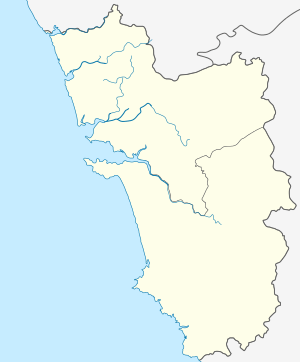Cuncolim
| Cuncolim कुंकळी | |
|---|---|
| city | |
 Cuncolim  Cuncolim Location in Goa, India | |
| Coordinates: 15°10′12″N 73°58′48″E / 15.17000°N 73.98000°ECoordinates: 15°10′12″N 73°58′48″E / 15.17000°N 73.98000°E | |
| Country |
|
| State | Goa |
| District | South Goa |
| Elevation | 18 m (59 ft) |
| Population (2001) | |
| • Total | 15,848 |
| Languages | |
| • Official | Konkani |
| Time zone | IST (UTC+5:30) |
| Vehicle registration | GA |
| Website |
goa |
Cuncolim is a city and a municipal council in South Goa district in the state of Goa, India.
Etymology
The name Cuncolim is derived from the fact that the village was known as Kumkumahalli (village where kumkum or vermilion is produced).[1]
Geography
Cuncolim is located at 15°10′N 73°59′E / 15.17°N 73.98°E.[2] It has an average elevation of 18 metres (59 feet).
History
It is a former village, now with a municipal council of its own, in the south Goa sub-district (taluka) of Salcette, India. It is part of the AVC (Assolna-Velim-Cuncolim) network of villages.
Historically, there were twelve Vangodds (clans) of Ganvkars (landlords) in the village. Their names, in order of precedence, are as follows: Mhal, Shetcar, Naik, Mangro, Shet, Tombddo, Porobo, Sidakalo, Lokakalo, Bandekar, Rounom and Benklo.[3]
Cuncolim was the site of recurring Hindu dissent against Portuguese rule, and this village is also known for an early violent protest against the Portuguese, in 1583. Those killed on the Christian side include the so-called 'martyrs of Cuncolim'.
The village of Cuncolim was the original site of the famous temple of Shree Shantadurga before this was demolished by the Portuguese in collaboration with the Christian missionaries. The Holy idol of Shree Shantadurga was taken to Fatorpa where the new temple of Shree Shantadurga Cuncolikarin stands today. The annual zatra of the temple happens in December /January where the Utsav which lasts for five days.
The chariots depicting scenes of different Hindu mythological events are paraded on each night. On the fifth day the Maha chariot of the Goddess is taken in a procession around the temple which is attended by devotees from all cast and creed from across Goa as well as the neighbouring states. This yatra is also attended by many local Christian families who continue to hold sacred their familial allegiance to the Goddess.
During the last days of the Holi festival, the idol of the Goddess is taken back to the original site at Cuncolim thus re-enacting the migration of the Goddess and many Hindu families who fled Salcette to preserve their faith. This marks the famous festival known as the Sontreo (Umbrellas) consisting 12 umbrellas representing 12 vangodds (clans) of Cuncolim.
Amongst those Hindu communities that fled Cuncolim in the midst of religious persecution are the Kunbis, Gawdas, Daivadnyas and Saraswats. The Saraswats from Cuncolim and Quelossim formed a separate community called the Chitrapur Saraswats and they have their math headquarters in Chitrapur, Karnataka.
Demographics
As of 2001 India census,[4] Cuncolim had a population of 15,848. Males constitute 49% of the population and females 51%. Cuncolim has an average literacy rate of 78%, higher than the national average of 59.5%: male literacy is 83% and, female literacy is 74%. In Cuncolim, 9% of the population is under 6 years of age.
The village is inhabited by mostly Hindu and Roman Catholic Kshatriyas (also known as Chardos). [5][6]
Education
It has 5 high schools namely Our Lady of Health, Cuncolim United, Infant Jesus, Maria Bambina Convent and Hutatma Kenkre High School. Higher secondary needs are catered to by Maria Bambina and United Higher secondary, former has Arts and Commerce stream whereas latter has both the streams in addition to Science. Cuncolim United College is the only college in Cuncolim which mostly has students from areas surrounding Cuncolim. Prabal's Institute of Commerce and Computer Education has been imparting typing and computer skills for the last 25 years.
Culture
Cuncolim has a unique traditional village irrigation, involving 12 bunds (water-gathering centers). It has also 12 residential clans (or vangodds). Cuncolim Union is one of the social organizations formed by people of this area.
Places of interest
Besides the church and chapels, Cuncolim is also home to seven temples, the Molanguinim Cave, small waterfalls at the foot of the seven temples, and the Nayaband Lake.
References
- ↑ News item from goacom.com website dated 06-Jan-2006
- ↑ Falling Rain Genomics, Inc - Cuncolim
- ↑ Cuncolim: Weaving a tale of resistance., Rowena Robinson, Economic and Political Weekly, 1997, p. 334
- ↑ "Census of India 2001: Data from the 2001 Census, including cities, villages and towns (Provisional)". Census Commission of India. Archived from the original on 2004-06-16. Retrieved 2008-11-01.
- ↑ Caste rivalry threatens to disrupt harmony in Goa - Indian Express, 2000
- ↑ India's forgotten 1583 uprising in Cuncolim - Armstrong Vaz, Mangalorean.com